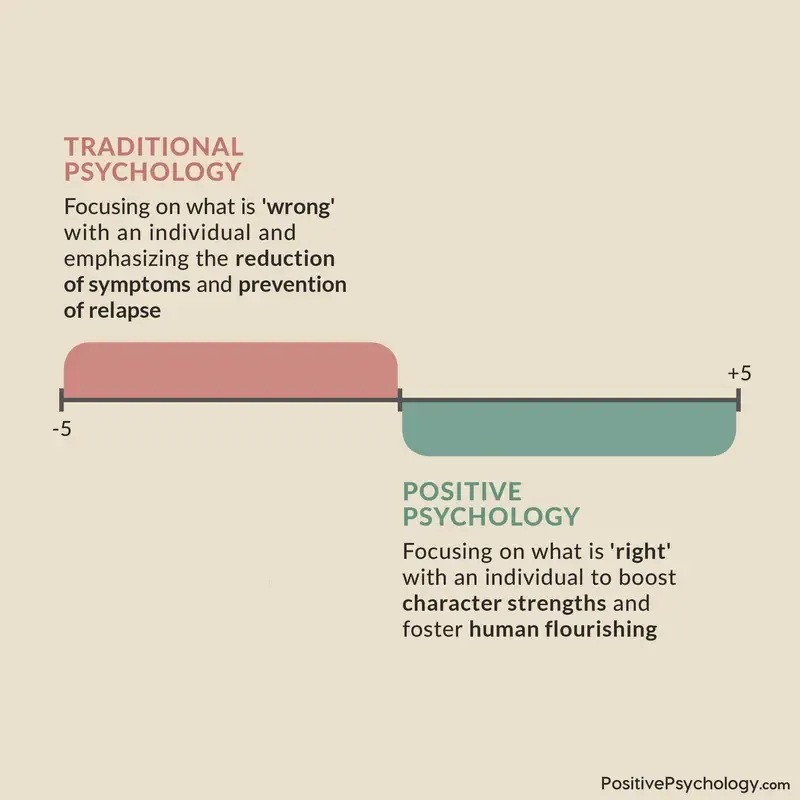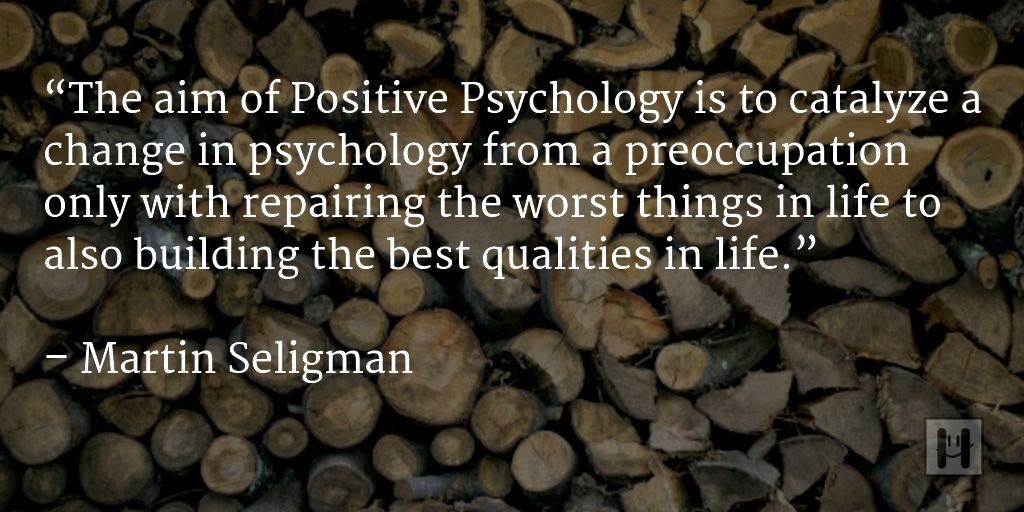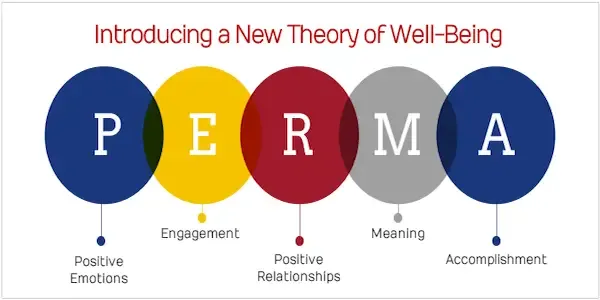What Is Positive Psychology & Why Is It Important?
 If you’ve been hearing the term “positive psychology” thrown around a lot, but you’re not quite sure what it is, you’ve come to the right place!
If you’ve been hearing the term “positive psychology” thrown around a lot, but you’re not quite sure what it is, you’ve come to the right place!
There are some common misconceptions about positive psychology, both about what it is and what it is not.
To clear up some of these misunderstandings and provide a brief but comprehensive overview of the field, we’ve put together this piece focused on defining and describing the positive psychology movement.
Before you read on, we thought you might like to download our three Positive Psychology Exercises for free. These science-based exercises will explore fundamental aspects of positive psychology including strengths, values and self-compassion and will give you the tools to enhance the wellbeing of your clients, students or employees.
This Article Contains:
- What is Positive Psychology: A Definition
- On the Founder: Martin Seligman
- 17 Benefits of Positive Psychology
- Theory and Concepts
- Goals of Positive Psychology (in Coaching)
- An Introduction to the PERMA Model
- Meaning of Topics Like Flow and Flourishing
- Examples of Positive Psychology in Practice (+PDF)
- Criticism of the Movement in Perspective
- 7 Other Definitions
- A Take-Home Message
- References
What is Positive Psychology: A Definition
Positive psychology has been described in many ways and with many words, but the commonly accepted definition of the field is this:
“Positive psychology is the scientific study of what makes life most worth living” (Peterson, 2008).
To push this brief description a bit further, positive psychology is a scientific approach to studying human thoughts, feelings, and behavior, with a focus on strengths instead of weaknesses, building the good in life instead of repairing the bad, and taking the lives of average people up to “great” instead of focusing solely on moving those who are struggling up to “normal” (Peterson, 2008).
What Positive Psychology Focuses on in a Nutshell
Positive psychology focuses on the positive events and influences in life, including:
- Positive experiences (like happiness, joy, inspiration, and love).
- Positive states and traits (like gratitude, resilience, and compassion).
- Positive institutions (applying positive principles within entire organizations and institutions).
As a field, positive psychology spends much of its time thinking about topics like character strengths, optimism, life satisfaction, happiness, wellbeing, gratitude, compassion (as well as self-compassion), self-esteem and self-confidence, hope, and elevation.
These topics are studied in order to learn how to help people flourish and live their best lives.
On the Founder: Martin Seligman
Martin Seligman is a researcher with a broad range of experience in psychology.
If you had never heard of the positive psychology movement until now, you still might have heard his name at some point. Seligman’s research in the 1960s and 70s laid the foundation for the well-known psychological theory of “learned helplessness.”
This theory, which has been backed by decades of research, explains how humans and animals can learn to become helpless and feel they have lost control over what happens to them.
Seligman connected this phenomenon with depression, noting that many people suffering from depression feel helpless as well. His work on the subject provided inspiration, ideas, and evidence to back up many treatments for depressive symptoms, as well as strategies for preventing depression.
While this is impressive enough on its own, Seligman knew that he had more to offer the psychology community and the world at large—in particular, more work on the positive, the uplifting, and the inspiring. After making a name for himself with learned helplessness, he turned his attention to other traits, characteristics, and perspectives that could be learned.
He found what he was looking for in resilience and learned optimism, findings that became the groundwork for his widely administered resilience programs for children and members of the military, among others.
Seligman grew frustrated with psychology’s overly narrow focus on the negative; so much attention was paid to mental illness, abnormal psychology, trauma, suffering, and pain, and relatively little attention was dedicated to happiness, wellbeing, exceptionalism, strengths, and flourishing.
When he was elected president of the American Psychological Association in 1998, he jumped at the opportunity to alter the direction of the field from such an influential position. He proposed a new subfield of psychology with a focus on what is life-giving rather than life-depleting. The foundational paper of this new field, positive psychology, was published in 2000 by Seligman and the “founding father” of flow, Mihaly Csikszentmihalyi.
Since 2000, Seligman’s call for a greater focus on the positive in life has been answered by thousands of researchers around the world, provoking tens of thousands of studies on positive phenomena and establishing a base for the application of positive principles to coaching, teaching, relationships, the workplace, and every other life domain.
17 Benefits of Positive Psychology

The plethora of projects and papers on positive topics has provided an enormous repository of knowledge on how to encourage ourselves and those around us to live the best lives possible.
It would be impossible to list all of the benefits of positive psychology, but we’ll try to give a comprehensive overview of some of the most impactful and influential outcomes of practicing positive psychology.
In general, the greatest potential benefit of positive psychology is that it teaches us the power of shifting one’s perspective.
This is the focus of many techniques, exercises, and even entire programs based on positive psychology because a relatively small change in one’s perspective can lead to astounding shifts in wellbeing and quality of life. Injecting a bit more optimism and gratitude into your life is a simple action that can give you a radically more positive outlook on life.
Of course, no respected positive psychologist would tell you to think about, act out, and focus on ONLY the positive in life—balance is important. Positive psychology was not established to replace traditional psychology, but to complement it with a positive bias that’s just as strong as psychology’s negative bias over the last several decades.
Studies and Research
Positive psychology teaches how to harness the power of shifting one’s perspective to maximize the potential for happiness in many of our everyday behaviors. For example, each of these findings gives us a concrete idea for improving our own quality of life:
- People overestimate the impact of money on their happiness by quite a lot. It does have some influence, but not nearly as much as we might think, so focusing less on attaining wealth will likely make you happier (Aknin, Norton, & Dunn, 2009);
- Spending money on experiences provides a bigger boost to happiness than spending money on material possessions (Howell & Hill, 2009);
- Gratitude is a big contributor to happiness in life, suggesting that the more we cultivate gratitude, the happier we will be (Seligman, Steen, Park, & Peterson, 2005);
- Oxytocin may provoke greater trust, empathy, and morality in humans, meaning that giving hugs or other shows of physical affection may give you a big boost to your overall wellbeing (and the wellbeing of others; Barraza & Zak, 2009);
- Those who intentionally cultivate a positive mood to match the outward emotion they need to display (i.e., in emotional labor) benefit by more genuinely experiencing the positive mood. In other words, “putting on a happy face” won’t necessarily make you feel happier, but putting in a little bit of effort likely will (Scott & Barnes, 2011);
- Happiness is contagious; those with happy friends and significant others are more likely to be happy in the future (Fowler & Christakis, 2008);
- People who perform acts of kindness towards others not only get a boost in wellbeing, they are also more accepted by their peers (Layous, Nelson, Oberle, Schonert-Reichl, & Lyubomirsky, 2012);
- Volunteering time to a cause you believe in improves your wellbeing and life satisfaction and may even reduce symptoms of depression (Jenkinson et al., 2013);
- Spending money on other people results in greater happiness for the giver (Dunn, Aknin, & Norton, 2008).
Positive psychology also lends itself to improvements in the workplace; studies from the field have found that:
- Positive emotions boost our job performance;
- Positive emotions in the workplace are contagious, which means one positive person or team can have a ripple effect that extends through the entire organization;
- Small, simple actions can have a big impact on our happiness, meaning that it doesn’t take much to encourage your workplace to become a happier and more positive place (Kjerulf, 2016).
One of the benefits of practicing a positive psychological outlook is, to put it broadly, success! Not only does success make us happier, feeling happy and experiencing positive emotions actually increases our chances of success (Lyubomirsky, King, & Diener, 2005).
However, don’t assume that refusing to brook any encroachment of negative emotions or outlooks will help you reach success. An important finding from positive psychology research is that forcing people who are not naturally optimists to “just think positively” can do more harm than good; unrealistic optimism is detrimental, along with intense pessimism (del Valle & Mateos, 2008; Dillard, Midboe, & Klein, 2009).
Another broad benefit of the positive psychology movement is a more well-defined idea of what “the good life” is.
Renowned positive psychologist Roy F. Baumeister and colleagues took on the challenge of determining what makes a good life, and they found some interesting findings that you can apply to your own life (2013). Their research showed that happiness and a sense of meaning in life do not necessarily go hand-in-hand, indicating that focusing on positive emotions alone will not bring the fulfilling and satisfying life you crave.
Some of their more specific findings included the following:
- The satisfaction of one’s wants and needs boost happiness, but have virtually no impact on meaningfulness; this indicates that focusing on obtaining what you want will increase your happiness, but you may have to supplement to get a deeper sense of meaning.
- Happiness is present-oriented, rooted in the moment, while meaningfulness is more focused on the past and future and how they link to the present; this finding suggests that you can focus on the present to increase your happiness, but you might consider thinking more about your past and future to find meaning.
- “Givers” experience more meaning, while “takers” experience more happiness; if you find yourself lacking in meaning, try giving back to others, but if you are lacking in happiness, try being accepting of others’ generosity to give yourself a boost.
- Worry, stress, and anxiety are more likely to be felt by those whose lives are high in meaningfulness and low in happiness; this indicates that you shouldn’t get too down about experiencing negative emotions if you have a strong sense of meaning—a little negative emotion can actually be a good thing!
- An intention to express your authentic self and a sense of strong personal identity are linked to meaning, but not to happiness; if you are searching for meaning, try working on your practice of authenticity.
Findings such as these have given rise to, and are driven by, a number of interesting theories that pepper the positive psychology literature.
Theory and Concepts

As University of Michigan professor and positive psychology legend Christopher Peterson put it:
“…positive psychology is not to be confused with untested self-help, footless affirmation, or secular religion—no matter how good these may make us feel. Positive psychology is neither a recycled version of the power of positive thinking nor a sequel to The Secret.” (2008)
Peterson goes on to outline the theories and concepts that have resulted from research so far (up to 2008, anyway):
- For the most part, most people are happy;
- Happiness is one of the causes of the good things in life, and also promotes more happiness;
- Most people are pretty resilient;
- Happiness, character strengths, and good social relationships act as buffers against disappointments and setbacks;
- Crises reveal character;
- Other people matter (in terms of what makes life worth living);
- Religion matters (and/or spirituality);
- Work also matters in terms of making life worth living, as long as we are engaged and draw meaning and purpose from it;
- Money has diminishing returns on our happiness after a certain point, but we can buy some happiness by spending money on other people;
- Eudaimonia (wellbeing, deeper form of satisfaction than happiness) is more important than hedonism (sole focus on pleasure and positive emotions) for living the good life;
- The “heart” matters more than the “head,” meaning that things like empathy and compassion are just as important as critical thinking;
- Nearly all good days have three things in common: a sense of autonomy, competence, and connection to others;
- The good life can be taught.
For an overview of some of the most salient theories and concepts in positive psychology, the website positivepsychology.org.uk offers a great “mind map” of the field here. We’ll also cover a couple of the biggest topics later in this piece.
Goals of Positive Psychology (in Coaching)
Applying positive psychology to coaching can be a tricky business, but it is undertaken with the best of intentions and care for others.
In general, the goals of positive psychology in coaching are as follows:
- To positively impact the client’s life—this goal is above all others, and all others feed indirectly into this goal. The main goal of coaching is to improve the client’s life. Positive psychology coaching is no different;
- Increase the client’s experience of positive emotions;
- Help clients identify and develop their strengths and unique talents;
- Enhance the client’s goal-setting and goal-striving abilities;
- Build a sense of hope into the client’s perspective;
- Cultivate the client’s sense of happiness and wellbeing;
- Nurture a sense of gratitude in the client;
- Help the client build and maintain healthy, positive relationships with others;
- Encourage the client to maintain an optimistic outlook;
- Help the client learn to savor every positive moment (Mentor Coach, n.d.; Peppercorn, 2014).
You can probably easily see why the first goal is the biggest, and basically subsumes all the other goals. Each of Goals 2 through 10 can be considered milestones on the way to Goal 1—effective techniques and objectives that help the client and coach work their way towards the client’s biggest life goals.
Where does positive psychology fit within the field of psychology?
Let’s consider a continuum ranging from -5 to +5. -5 represents those in our community who suffer from mental health problems while +5 represents those who are flourishing and living a fulfilling life. 0 represents those who neither have a mental health problem nor are flourishing.
Traditionally, psychology has taken a ‘weakness’ focus, training practitioners to focus on what is going ‘wrong’ with an individual in order to reduce and potentially remove their symptoms. This is a valuable focus and in doing so, practitioners work to move their clients from -5 to 0 on this continuum.
But, how can we go further and help people truly flourish and live a meaningful life? This is where positive psychology comes in. It trains practitioners to consider what is going ‘right’ with an individual and cultivate ways in which to boost their strengths and promote human flourishing.
This is an equally valuable focus and in doing so, practitioners help clients move from 0 to +5 on this continuum and, more importantly, towards positive wellbeing.

An Introduction to the PERMA Model
The PERMA model is a widely recognized and influential model in positive psychology. Seligman proposed this model to help explain and define wellbeing in greater depth.
“PERMA” is an acronym for the five facets of wellbeing according to Seligman:
- P – Positive Emotions: Even though seeking positive emotions alone is not a very effective way to boost your wellbeing, experiencing positive emotion is still an important factor. Part of wellbeing is enjoying yourself in the moment, i.e., experiencing positive emotions;
- E – Engagement: Having a sense of engagement, in which we may lose track of time and become completely absorbed in something we enjoy and excel at, is an important piece of wellbeing. It’s hard to have a developed sense of wellbeing if you are not truly engaged in anything you do;
- R – (Positive) Relationships: Humans are social creatures, and we rely on connections with others to truly flourish. Having deep, meaningful relationships with others is vital to our wellbeing;
- M – Meaning: Even someone who is deliriously happy most of the time may not have a developed sense of wellbeing if they do not find meaning in their life. When we dedicate ourselves to a cause or recognize something bigger than ourselves, we experience a sense of meaning that there is simply no replacement for;
- A – Accomplishment / Achievement: We all thrive when we are succeeding, achieving our goals, and bettering ourselves. Without a drive to accomplish and achieve, we are missing one of the puzzle pieces of authentic wellbeing (Seligman, 2011).
This model gives us a comprehensive framework for understanding wellbeing as well as a foundation for improving wellbeing. If you’re looking to enhance your own sense of authentic happiness and wellbeing, all you need to do is focus on:
- Experiencing more positive emotions; do more of the things that make you happy, and bring enjoyment into your daily routine;
- Working on upping your engagement; pursue hobbies that interest you, develop your skills, and look for a job more suited to your passions, if necessary;
- Improve the quality (and/or quantity) of your relationships with others; work on building more positive and supportive relationships with your friends, family, and significant other(s);
- Seek out meaning; if you don’t find it through your work, look for it in volunteering opportunities, personal hobbies or leisure activities, or acting as a mentor for others;
- Keep your focus on achieving your goals—but don’t focus too hard; try to keep your ambition in balance with all of the other important things in life (Seligman, 2011).
These five aspects of the PERMA model are measurable, and also vital for an overall sense of wellbeing. This model pushes past the older model of authentic happiness in its consideration of more than just happiness or positive emotions. Of course, positive emotions are important—they’re part of the PERMA model itself, after all—but focusing just on positive emotions will not help you to develop a comprehensive sense of wellbeing, including engagement, meaning, success, and positive relationships with others.
Happiness alone will likely not propel you towards flourishing, but wellbeing will.
Meaning of Topics Like Flow and Flourishing
Speaking of flourishing, it’s a concept we’ve touched on in this piece already, but have not yet defined. We’ve also mentioned the topic of flow, though indirectly, which is an important concept in positive psychology as well.
Understanding these concepts is vital for understanding the field of positive psychology. Read on to learn more about them.
Flourishing
Flourishing is one of the most significant concepts in positive psychology, as it encompasses and extends to so many other positive concepts.
In short, “flourishing” refers to the state we are in when we pay attention to each aspect of the PERMA model and build up a solid sense of wellbeing. We flourish when we cultivate our talents and strengths, develop deep and meaningful relationships, feel pleasure and enjoyment, and make a meaningful contribution to the world.
We flourish when we find fulfillment in life along with achieving more traditional objectives related to success when we are truly living the “good life” (Seligman, 2011).
Positive psychologist and professor Dr. Lynn Soots (n.d.) describes flourishing as the following:
“Flourishing is the product of the pursuit and engagement of an authentic life that brings inner joy and happiness through meeting goals, being connected with life passions, and relishing in accomplishments through the peaks and valleys of life.”
Further, Soots emphasizes that flourishing is not a trait, a characteristic, or something you “either have or don’t have;” rather, flourishing is a process that requires action. While it might be disappointing that it doesn’t come easy, it’s encouraging to know that, truly, anyone can flourish!
Flow
Another well-known topic in positive psychology is that of flow.

The concept of flow was first scientifically explored and defined by Mihaly Csikszentmihalyi (our second “founding father” of positive psychology).
In the last few decades of the 1900s, Csikszentmihalyi noticed that many artists fell into a particular state while they were working; this state was characterized by a particularly intense focus and great concentration on the task at hand, to the point of losing track of time for hours at a time.
He continued pursuing this topic and noticed it in others as well. Professional athletes, musicians, writers, and people from all sorts of artistic and creative trades frequently reported losing themselves into their work in a similar way. As he gathered more descriptions of this phenomenon, he observed six factors that characterize a flow experience:
- Intense and focused concentration on the present moment;
- The merging of action and awareness, or being fully present in your actions;
- A loss of reflective self-consciousness (lack of attention to the self);
- A sense of personal control or agency in the situation;
- A distorted sense of time passing;
- Experiencing the activity or situation as intrinsically rewarding (Csikszentmihalyi, 1975).
Those who enter into a state of flow are totally immersed in what they’re doing. This immersion arises when the challenges of the activity in front of us are significant and roughly equal to our skill at this activity.
When we have high skill and low challenge, we are bored. When we have a high challenge and low skill, we are overwhelmed. When we have “low skill and low challenge,” we are apathetic. It is only when both our skill and our challenges are high that we enter into a flow state.
Entering into flow is intrinsically rewarding and often an enjoyable experience; flow also seems to link to greater happiness and wellbeing, more academic (and, subsequently, career) success, and more positive and healthy relationships (Csikszentmihalyi & Csikszentmihalyi, 1988).
To learn more about flow, Csikszentmihalyi gave an outstanding TED Talk on the subject.
If the video only piqued your interest, you may want to consider buying Csikszentmihalyi’s books on flow:
- Finding Flow: The Psychology of Engagement with Everyday Life (1998)
- Flow: The Psychology of Optimal Experience (2008)
- Creativity: Flow and the Psychology of Discovery and Invention (2013)
Examples of Positive Psychology in Practice (+PDF)

Positive psychology principles and exercises can be applied in several different settings, including therapy, the classroom, the workplace, and in your own home.
Some of the techniques that have proven most useful include:
The use of the experience sampling method (or ESM), also referred to as a daily diary method.
Before the days of smartphones, you would be given a beeper or pager that goes off at random points during the day, alerting you to pause, notice what you were thinking, feeling, and doing at that moment, and writing it all down. This is often used in positive interventions to help people realize how much of their day is actually quite positive.
The practice of keeping a gratitude journal.
A gratitude journal offers individuals a method of identifying and reflecting on all of the good things in their lives—all the things they have to be grateful for. Interventions often involve prompting people to write down three things they are grateful for each day, with the only stipulation being that they need to be different each day. Within a week, many people experience a boost in wellbeing along with an increase in gratitude.
Making a gratitude visit.
A gratitude visit (or letter) is an exercise in which an individual identifies a person to whom he or she is grateful and why; once they have these in mind, they can write a letter to this person expressing and explaining their gratitude.
If the person lives close enough to visit, they are encouraged to drop off the letter in person and visit with them; if not, a phone call, video chat, or simply dropping the letter in the mail can work as well. This exercise provides a significant boost to both gratitude and wellbeing.
Focusing on building personal strengths instead of weaknesses.
One of the most significant differences between many other forms of coaching and counseling and one based in positive psychology is the focus on strengths instead of weaknesses.
Positive psychology is based on the idea that building on our strengths is often a more effective path to success than trying to force excellence in areas we are simply not suited for. In practice, this technique involves identifying one’s strengths and working to provide yourself with more opportunities to use them.
Wellbeing therapy.
This holistic approach to therapy is similar to cognitive-behavioral therapy (CBT) but focuses on both promoting the positive and alleviating the negative in the client’s life.
It is founded on Carol Ryff’s model of wellbeing, which recognizes six facets or factors of wellbeing: mastery of the environment, personal growth, purpose in life, autonomy, self-acceptance, and positive relationships (Harvard Health Publishing, 2008).
Positive psychotherapy.
Positive psychotherapy is similar to wellbeing therapy, but generally packages several techniques and exercises into one treatment. Its focus is on building positive emotions, character strengths, and a sense of meaning in life. Twelve exercises are generally practiced in this form of therapy, including exercises on using your signature strengths, keeping a gratitude journal, making a gratitude visit (Harvard Health Publishing, 2008).
To read more about the power of putting positive psychological principles into practice, check out the aptly titled book, Positive Psychology in Practice, by positive psychologists P. Alex Linley and Stephen Joseph at this link. This book will walk you through the major facets of applying the relevant findings from the positive psychology literature, including:
- The applied positive psychology perspective;
- Historical and philosophical foundations;
- Values and choices in pursuit of the good life;
- Lifestyle practices for health and wellbeing;
- Methods and processes for teaching and learning;
- and positive psychology at work.
For more tools, exercises and techniques of positive psychology, click here for the free eBook with 3 positive exercises.
Criticism of the Movement in Perspective

At the 2015 World Conference of Positive Psychology, some of the biggest names in positive psychology discussed a few of these criticisms. Below, we’ll outline some of the major criticisms and an evaluation of their merit in today’s field.
Research findings are often invalid, overstated, and misleading.
Like any other scientific field, mistakes are sometimes made. This often seems to be due to excitement over the potential of findings in positive psychology; it can be hard to maintain objectivity when you feel a finding has both broad and deep applicability to the real world.
However, this is no excuse for a lack of scientific rigor. While there is a bit more leeway in crossing your “t”s and dotting your “i”s in applied research, positive psychologists must be careful to keep their claims within reason and think critically about the limitations of their methods—there is always a limitation!
Today, positive psychology has overcome some of the initial obstacles and growing pains inherent to a new field. More critical attention is being paid to the research, which gives us all more confidence in the findings.
There is too much emphasis on self-report and cross-sectional survey data.
This is certainly a valid point; much of the positive psychology literature is built on survey data. However, this emphasis on survey data is not exclusive to positive psychology, and positive psychology does not exclusively use surveys. Receiving feedback from those close to an individual is increasingly being utilized to corroborate or compare self-report data to, which increases confidence in data.
Although positive psychology is not alone in this limitation, it is one that positive psychologists should continue to consider when planning, implementing and reviewing research.
Positive psychology has a cultural and ethnocentric bias.
It’s true that much of the research in positive psychology has been published by Western scholars, editors, reviewers, and journals. It is also true that positive psychology generally embraces a white, middle-class audience, in which injustice, poverty, and inequality are swept under the rug.
However, this bias seems to have been much over-hyped. Recently, more research from experts in non-Western countries and from a diverse range of backgrounds is being conducted (and published). The recent establishment of the International Positive Psychology Association is one sign of this attempt at broadening the perspective of positive psychology.
The field is too individualistic.
Another valid point is that positive psychology focuses too much on the individual—on personal experiences, individual traits and characteristics, and intrapersonal processes and phenomena. Positive psychology does indeed seem to have an overly narrow focus on the individual and a lack of attention paid to relationships, teams, groups, organizations, and communities.
Some have argued that this focus on individuals leads positive psychology to victim-blame (e.g., “If you can’t figure out how to be happy, it’s your fault”) and excuse those who are contributing to systemic issues (e.g., “It’s too hard to make corporations act ethically, so we’ll just help you make the best of it.”).
Positive psychology is just a promotion of a “Pollyanna” personality type, not an authentic exploration of the good life.
Of the major critiques of positive psychology, this may be one of those with the least merit. Although there is a good deal of research on “Pollyanna” types (happy, bubbly, cheerful, extroverted), that research is by no means representative of the entire field.
As cited earlier, there are studies on the dark side of happiness and optimism and the benefits of thinking pessimistically. There are also myriad studies on people from all across the spectrum of personality, from quiet and successful introverts to boisterous and struggling extroverts, and on the lack of fulfillment and meaning in the lives of some of the most “bubbly” individuals.
On the surface, it may seem that positive psychology is the study of the perpetually happy, but anything more than a cursory look will show you that the field is a rich exploration of all that which makes life good (and a bit of what makes it difficult as well).
Some of the criticisms of the field make excellent points.
Rather than struggling against these points, we should be open to considering them, thinking critically about the health of our field, and coming up with solutions for any big problems.
No field is immune from criticism, nor should it be; a healthy debate and a robust peer review process is what will keep positive psychology theory from lapsing into nothing more than an edict to “be positive” and positive psychology interventions from devolving into self-help material that is based on nothing but opinions or wishful thinking.
7 Other Definitions
Watch this video to find out what Positive Psychology means to The Positive Psychology People (website) and some of the most influential researchers in the field:
Definition 1:
“Positive psychology is the study of the conditions and processes that contribute to the flourishing or optimal functioning of people, groups, and institutions.”
Source: Gable, Shelly L., Haidt, Jonathan, What (and Why) Is Positive Psychology? (PDF), MichaelGeorge.com
Definition 2:
“Positive psychology is the branch of psychology that uses scientific understanding and effective intervention to aid in the achievement of a satisfactory life, rather than merely treating mental illness.”
Source: Wikipedia
Definition 3:
“Positive psychology studies what makes life most worth living.”
Source: Peterson, Christopher, What is positive psychology and what is it not?
Definition 4:
“Positive Psychology is the scientific study of human flourishing, and an applied approach to optimal functioning. It has also been defined as the study of the strengths and virtues that enable individuals, communities, and organisations to thrive.”
Source: Positive Psychology Institute.
Definition 5:
“Positive psychology cannot be confined to any dogmas carved in stone, because it is always subject to influences by new creative ideas, pressing human needs, and changing circumstances.”
According to Paul Wong, the underlying theme of positive psychology is that life can be made better for all people if certain conditions are met.
Source: Wong, Paul T. P., Wong, Lilian C. J., McDonald, Marvin J., Klaassen, Derrick W., 2012, The Positive Psychology of Meaning and Spirituality
Definition 6:
“Positive psychology is the scientific study of human strengths and virtues.”
According to Martin Seligman—who is seen as the founding father of positive psychology—the positive psychology movement can be described as:
“The study of what constitutes the pleasant life, the engaged life, and the meaningful life.”
Source: Batthyany, Alexander, Russo-Netzer, Pninit, Meaning in Positive and Existential Psychology
Definition 7:
“Positive psychology is the scientific and applied approach to uncovering people’s strengths and promoting their positive functioning” (Hugo Alberts).
Or:
“Positive psychology studies what is going right with the human mind and behaviour and how to foster these types of wellbeing on both the macro-, group-, and individual-level” (Seph Fontane Pennock).
Source: PositivePsychology.com
What is Positive Psychology and How Did it Come into Being?
The question “what is wrong with people” has guided the thinking of many researchers and dominated countless scientific studies during the 20th century. It is hard to deny that this entails an important question.
In our attempts to answer the question, we have gained more understanding of many illnesses and have developed effective treatments for a wide range of problems.
However, as an inevitable consequence of our focus on the negative aspects of wellbeing and health, such as distress and disease, we developed an almost exclusive attention to pathology.
We believe that science has focused disproportionately on pathology and repair, and devoted relatively little attention to factors that “make life worth living.”
As the 21st century unfolds, however, we are beginning to ask a different question: “What is right about people?”
This question is at the heart of positive psychology, which is the scientific and applied approach to uncovering people’s strengths and promoting their positive functioning.
During the past 14 years, the number of scientific studies on positive psychology has increased tremendously. In addition, countless interventions have been developed to increase people’s wellbeing.
A Take-Home Message
We hope this article has given you a good understanding of positive psychology—what it is, what it isn’t, where it’s been, and where it’s going.
Positive psychology is a field with a huge potential for improving the lives of people around the world, and many impactful findings have already been discovered.
The bottom line is this: if you want to keep up in the world of coaching, teaching, counseling, therapy, and a dozen other domains, make sure to keep an eye out for what’s new in positive psychology!
What are your thoughts on the state of the field? Do you think there are bigger criticisms that are being ignored? Do you think the field is doing a good job at solving the problems it set out to solve? What do you think is the “next big thing” in positive psychology? Please let us know in the comments section below.
Thanks for reading!
We hope you enjoyed reading this article. Don’t forget to download our three Positive Psychology Exercises for free.
- Aknin, L. B., Norton, M. I., & Dunn, E. W. (2009) From wealth to well-being? Money matters, but less than people think, The Journal of Positive Psychology, 4, 523-527.
- Barraza, J. A., & Zak, P. J. (2009). Empathy towards strangers triggers oxytocin release and subsequent generosity. Annals of the New York Academy of Sciences, 1167, 182-189.
- Baumeister, R. F., Vohs, K. D., Aaker, J., & Garbinsky, E. N. (2012). Some key differences between a happy life and a meaningful life. Journal of Positive Psychology, 8, 505-516.
- Del Valle, C. H. C., & Mateos, P. M. (2008). Dispositional pessimism, defensive pessimism and optimism: The effect of induced mood on prefactual and counterfactual thinking and performance. Cognition & Emotion, 22, 1600-1612.
- Dillard, A. J., Midboe, A. M., & Klein, W. M. P. (2009). The dark side of optimism: Unrealistic optimism about problems with alcohol predicts subsequent negative event experiences. Personality & Social Psychology Bulletin, 35, 1540-1550.
- Dunn, E. W., Aknin, L. B., & Norton, M. I. (2008). Spending money on others promotes happiness. Science, 319, 1687-1688.
- Fowler, J. H., & Christakis, N. A. (2008). Dynamic spread of happiness in a large social network: Longitudinal analysis over 20 years in the Framingham Heart Study. The BMJ, 337.
- Harvard Health Publishing. (2008). Positive psychology in practice. Harvard Mental Health Letter. Retrieved from https://www.health.harvard.edu/mind-and-mood/positive_psychology_in_practice
- Howell, R. T., & Hill, G. (2009). The mediators of experiential purchases: Determining the impact of psychological needs satisfaction and social comparison. The Journal of Positive Psychology, 4, 511–522.
- Jenkinson, C. E., Dickens, A. P., Jones, K., Thompson-Coon, J., Taylor, R. S., Rogers, M., Bambra, C. L.,…, & Richards, S. H. (2013). Is volunteering a public health intervention? A systematic review and meta-analysis of the health and survival of volunteers. BMC Public Health, 13, 773-782.
- Kjerulf, A. (2016, January 18). The 5 most important findings from the science of happiness that apply at work. The Chief Happiness Officer Blog. Retrieved from https://positivesharing.com/2016/01/positive-psychology-at-work/
- Layous, K., Nelson, S. K., Oberle, E., Schonert-Reichl, K. A., & Lyubomirsky, S. (2012). Kindness counts: Prompting prosocial behavior in preadolescents boosts peer acceptance and well-being. PLoS ONE, 7.
- Lyubomirsky, S., King, L., & Diener, E. (2005). The benefits of frequent positive affect: Does happiness lead to success? Psychological Bulletin, 131, 803-855.
- Mentor Coach LLC. (n.d.). What IS positive psychology? MentorCoach – Positive Psychology & Coaching. Retrieved from http://www.mentorcoach.com/positive-psychology-coaching/
- Peppercorn, S. (2014). The benefits of positive psychology coaching. Positive Workplace Partners. Retrieved from http://positiveworkplacepartners.com/the-benefits-of-positive-psychology-coaching/
- Peterson, C. (2008). What is positive psychology, and what is it not? Psychology Today. Retrieved from https://www.psychologytoday.com/us/blog/the-good-life/200805/what-is-positive-psychology-and-what-is-it-not
- Scott, B. A., & Barnes, C. M. (2011). A multilevel field investigation of emotional labor, affect, work withdrawal, and gender. Academy of Management Journal, 54, 116-136.
- Seligman, M. E. P. (2011). Flourish: A visionary new understanding of happiness and well-being. New York City, NY: Atria Books.
- Seligman, M. E. P., Steen, T. A., Park, N., & Peterson, S. (2005). Positive psychology progress: Empirical validation of interventions. American Psychologist, 60, 410-421.
- Soots, L. (n.d.). Flourishing. Positive Psychology People. Retrieved from http://www.thepositivepsychologypeople.com/flourishing/
Let us know your thoughts
Read other articles by their category
- Body & Brain (42)
- Coaching & Application (56)
- Compassion (26)
- Counseling (50)
- Emotional Intelligence (24)
- Gratitude (18)
- Grief & Bereavement (21)
- Happiness & SWB (39)
- Meaning & Values (25)
- Meditation (20)
- Mindfulness (44)
- Motivation & Goals (43)
- Optimism & Mindset (32)
- Positive CBT (25)
- Positive Communication (20)
- Positive Education (44)
- Positive Emotions (30)
- Positive Leadership (13)
- Positive Psychology (32)
- Positive Workplace (33)
- Productivity (16)
- Relationships (42)
- Resilience & Coping (34)
- Self Awareness (20)
- Self Esteem (36)
- Software & Apps (22)
- Strengths & Virtues (30)
- Stress & Burnout Prevention (33)
- Theory & Books (44)
- Therapy Exercises (35)
- Types of Therapy (58)






What our readers think
Hello,
I am not a psychologist but love the science in psychology! I am a teacher and more concerned with students’ career guidance.For this matter,I would prefer including ‘Positive Psychology’ as a subject in Secondary school curriculum if we are to help everyone without waiting for counselling classes later on when someone is referred to as “a client” -who will possibly be a patient at that time.
This can help students catch up with living focused,valued lives much earlier in life instead of waiting to treat the signs and symptoms of negative psychology.
My suggestion is just a preventive measure!(Talking from Africa;I don’t know the stand else where).